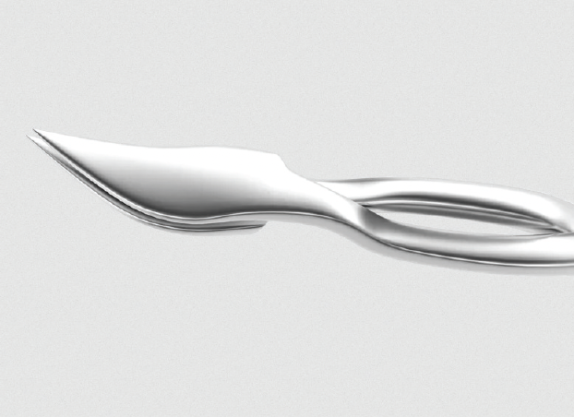
Phacoemulsification revolutionized cataract surgery, but dense cataracts and poor corneal endothelial function can make cracking the nucleus difficult. No single strategy or technology is suitable in all situations, so it is important for surgeons to find several that work for them.
There is no single best way to crack a nucleus. As surgical educators, it is our responsibility to expose ourselves to as many techniques as we can, find out what feels most natural to us, and share our learnings with our residents, fellows, and other colleagues. This article focuses on four different strategies that I favor using for fragmentation.
MILOOP
Once inserted in the eye, the flexible nitinol loop of the miLoop (Carl Zeiss Meditec) is expanded, positioned within the capsule and around the lens, and constricted to bisect the cataract. The cataract may then be rotated, and the maneuvers can be repeated to divide the lens further.
The miLoop is the only available device that cuts inward from the outside of the cataract. I have used it to cut through superdense lenses. One of my patients, for example, had a dense brunescent cataract and light perception vision in one eye and pseudophakic bullous keratopathy in the fellow eye. I knew that cataract surgery had to be gentle on the endothelium. Manual small-incision cataract surgery was not an option for the case, so I opted to use the miLoop, which successfully bisected the cataract despite the presence of a stubborn posterior plate.
The miLoop is a disposable device, so its use entails an additional cost, which can be an issue for some surgeons. Moreover, as with any device, there is a learning curve. I recommend starting by using the miLoop in routine cases to gain experience with the device before using it for dense cataracts.
OTHER APPROACHES
Laser cataract surgery. I believe the use of this technology can be beneficial in certain complex surgical scenarios such as eyes with concurrent cataract and Fuchs dystrophy. Studies have shown that less phaco cumulative dissipated energy is required in eyes undergoing laser versus standard cataract surgery.1 The clinical significance of this difference, however, is debatable. Retrospective and prospective studies have shown no clear benefit to performing laser cataract surgery on patients with Fuchs dystrophy.2,3
Some ophthalmologists favor the laser prefragmentation of dense cataracts. A potential challenge is that the passage of laser energy may be limited by a brunescent cataract, and fragmentation at the posterior plate is typically the hardest to achieve. On the other hand, laser prefragmentation can decrease the amount of cumulative dissipated energy in the eye and preserve endothelial cells.1
Prechopping. I learned about prechoppers during my fellowship with Brad H. Feldman, MD. They are typically used before initiating phacoemulsification. The blades are buried deep in the cataract and then opened to crack the cataract. I believe it is worthwhile for cataract surgeons to gain experience with prechoppers and determine if the instruments have a place in their armamentariums. I recommend starting with the Akahoshi choppers (Figure). Another similar device is nuclear crackers, which are used after creation of the initial phaco groove.

Figure. An Akahoshi Hybrid Combo Prechopper.
Courtesy of Rumex
Modified chopping techniques. This group of techniques can be useful for fragmenting cataracts while minimizing cumulative dissipated energy. A few examples include submarine chop, the pit technique, and rotary chop.4
These techniques target the posterior plate—the part of a dense cataract that tends to cause surgeons the most grief. After the posterior plate is cracked, it becomes safer to manipulate the lens fragments, and hemi-nuclei can be brought out of the bag with less zonular stress. I often use modified chop techniques because they do not require additional instrumentation or cost.
CONCLUSION
I look forward to seeing more advances and alternative strategies for phaco and nonphaco cataract surgery that can lead to improved safety, efficiency, and patient outcomes. For now, modifying my current fragmentation techniques or relying on certain devices like the miLoop and femtosecond laser systems can help tackle complex cases such as dense cataracts and cataract surgery in the presence of poor corneal endothelial function.
1. Oka Y, Sasaki N, Injev VP. Comparison of femtosecond laser-assisted cataract surgery and conventional phacoemulsification on endothelial cell density when using torsional modality. Clin Ophthalmol. 2021;15:4227-4237.
2. Koo EH, Paranjpe V, Feuer WJ, Persad PJ, Donaldson KE. Refractive outcomes in Fuchs’ endothelial corneal dystrophy: conventional and femtosecond laser-assisted cataract surgery. Clin Ophthalmol. 2021;15:3419-3429.
3. Krarup T, Rose K, Mensah AMA, la Cour M, Holm LM. Comparing corneal outcome between femtosecond laser-assisted cataract surgery and conventional phaco surgery in Fuchs’ endothelial dystrophy patients: a randomized pilot study with 6mo follow up. Int J Ophthalmol. 2021;14(5):684-692.
4. Ifantides C, Sieck EG, Christopher KL. Rotary chop: a new technique for teaching chop and tackling mature cataracts. Ophthalmol Ther. 2020;9(2):321-327.


